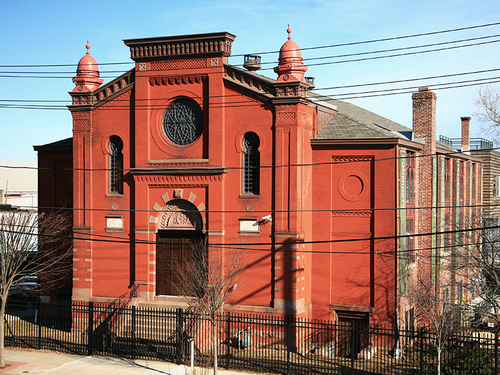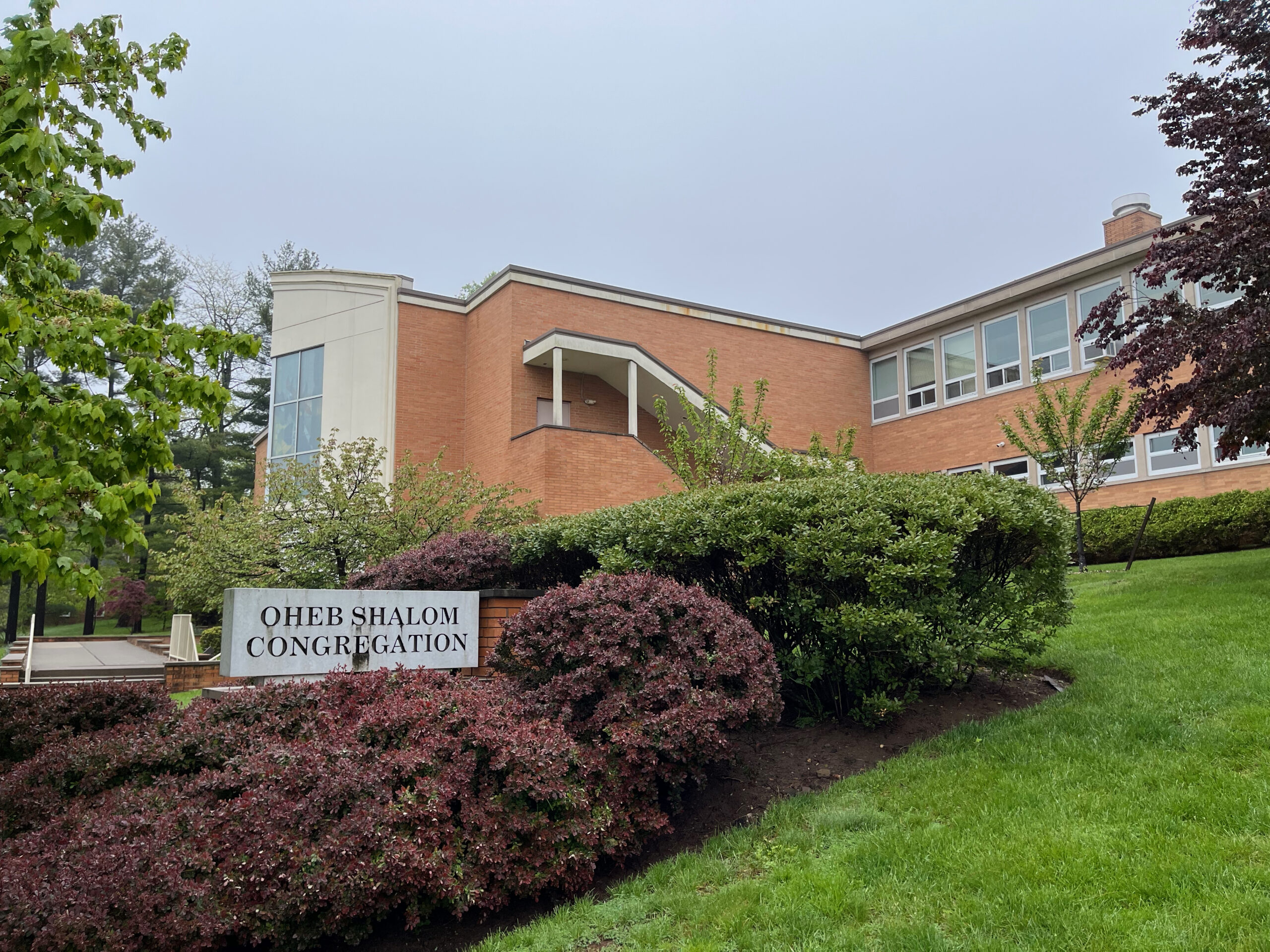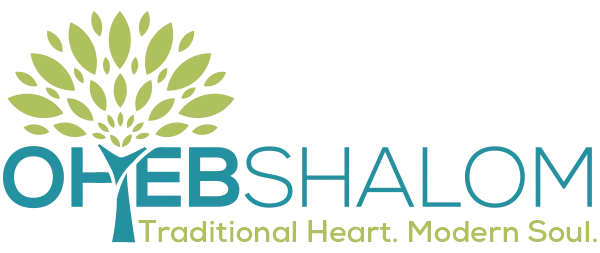History

The History of Oheb Shalom Congregation
Prince Street Formative Years (1860-1911)
In 1860, twelve years after Congregation B’nai Jeshurun (CBJ) was founded in Newark, a group of CBJ members met in the home of Bernard Hauser, a former CBJ President. Their purpose was to form a new synagogue that would adhere to Orthodox practices. Rabbi Isaac Schwarz, first Rabbi of B’nai Jeshurun, was chosen to become the first Rabbi of Oheb Shalom – “Lovers of Peace”. The name was selected in accordance with the tradition of those days that the name of a synagogue being formed from another should reflect that the leaving was not wrongful or caused by anger, but was to preserve shalom bayit, peace in the household. The congregation was founded on September 2, 1860 with its charter transmitted to the Essex County courts five weeks later. Dues were thirty-six cents per month.
Services were initially conducted in German and Hebrew in rented space on the top floor of a home on Prince Street between Springfield and South Orange Avenues. By 1864, the Congregation built a wooden synagogue structure on the west side of Prince Street a few doors away from the home. This building had a balcony for women, and men wore high silk hats during services. The Hebrew School, which had been in existence since the formation of the congregation, was taught by volunteer lay teachers who were required to be competent. The principal was a highly trained person who usually led prayer services. In 1866 the congregation bought land on South Orange Avenue in Newark for use as a cemetery, which exists to this day.
The second rabbi of Oheb Shalom was Rabbi Ferdinand Leopold Sarner who served for a short time. A native of Germany, he was the first rabbi to be appointed by the United States Army to serve as a regimental chaplain. Rabbi Sarner was severely wounded at the Battle of Gettysburg. In the 1870s, Rabbi Tintner came to Oheb Shalom and initiated the idea of forming a women’s auxiliary, resulting in the founding of Miriam Frauen Verein (now Miriam Sisterhood) in 1880.
With the arrival of Rabbi Bernard Drachman (1885-1888), who was born in America but received his rabbinical degree in Germany, English began to be used in the synagogue. He preached alternate weeks in German and English. Rabbi Drachman sought employment at Oheb because he wanted to serve American-born Jews who would respect his training and share his theology so that those of the second generation should follow traditional ritual and custom. The congregation saw in him a spiritual guide who integrated loyalty to Judaism with American mores.
Under Rabbi Wolf Willner (1888-1890), English replaced German during services. However, Miriam Verein still conducted much of its business in German, and its president’s annual message was delivered in German until 1917.
In 1884, with a membership of one hundred, the congregation erected a new brick building directly across from its white frame structure on Prince Street. At the dedication ceremony on September 14, 1884, the Torah scrolls were carried across the street by three young women. The brick synagogue, which cost over $25,000 to construct, is now a registered state historic site and home to Greater Newark Conservancy’s urban environmental center. This is the second oldest structure — originally built as a synagogue and still standing in New Jersey — and among the 35 oldest in the USA.
In this new building, as men and women began to sit together, the congregation adopted English as its official language by using the Szold-Jastrow Prayer Book. An organ was installed and used during services which were now led by a professional hazzan. The character of Oheb Shalom was changing. In 1890 Rabbi Bernard Gluck came to Oheb Shalom. During his tenure, the Prince Street building was expanded, property for another cemetery in Hillside was purchased, and the congregation continued to grow.
1906 was a turning point in the history of the congregation, with the arrival of Rabbi Charles I. Hoffman, a member of the first graduating class of the Jewish Theological Seminary of America, who was greatly influenced by his friend, teacher and mentor Solomon Schechter. Fearing that American Jewish youth would be “turned off” by Orthodox Judaism and turn to the Reform Movement, which they considered too radical, they sought a middle ground to build an American Judaism and conserve Hebraic tradition by refashioning ritual practice. At this time, the majority of the membership of the synagogue was American born and wanted to incorporate new styles, practices and rituals – “as Jewish as the Torah and as American as apple pie”. With the popularity of this view, the congregation grew and the Prince Street building was no longer suitable.
High Street Era (1911-1958)

In 1907 the decision was made to move, and a High Street (now Martin Luther King Blvd.) site was purchased. Groundbreaking and cornerstone laying took place in 1910, and the building was dedicated in 1911. Among the speakers at the dedication were Woodrow Wilson, then governor of New Jersey; Solomon Schechter, head of the Jewish Theological Seminary and leader of Conservative Jewry; and Dr. Solomon Solis-Cohen, leader of the Philadelphia Jewish Community. 1911 marked the creation of the Oheb Shalom Review under the editorship of M. David Hoffman, son of Dr. Hoffman. During this year, the Jewish Free Library opened in the new building, and Hebrew School volunteer principal and teachers were replaced by professionals.
A new cantor, Reverend Moses Gann, succeeded Max Helfere in 1913. A native of Russia, he studied Hebrew and Talmud in Russia before pursuing his musical education in Vienna before coming to the United States.
Also in 1913, Rabbi Hoffman and the rabbis of seven other congregations formed an organization that became the United Synagogue of America. In 1918 Fanny B. Hoffman (Rabbi Hoffman’s wife), encouraged by her friend Matilda Schechter, wife of Solomon Schechter, led Miriam Auxiliary to become a founding member of the Women’s League for Conservative Judaism. Oheb Shalom was now one of the leading Conservative congregations in the United States.
At the 1930 annual meeting, in the depths of the Depression, the congregation paid off the synagogue mortgage. A mortgage burning ceremony was held and lay leaders vowed never again to hold a mortgage, a promise that has held to this day!
In the 1930s and 40s, High Street was the focal point of Jewish life in Newark. It was a street lined with Jewish institutions – Congregation B’nai Jeshurun, Beth Israel Hospital (replaced by Daughters of Israel when the Beth moved to Lyons Avenue), the YM-YWHA, as well as Oheb Shalom.
Rabbi Leon S. Lang joined the congregation in 1927 as Dr. Hoffman’s assistant and placed his emphasis on youth, nurturing the high school which had started in 1925. He founded Kadimah and revitalized the Men’s Club during his twelve-year tenure. With the departure of Rabbi Lang, Dr. Hoffman decided to retire. After an extensive search, Oheb Shalom called Dr. Louis M. Levitsky from his pulpit in Wilkes-Barre, PA to be its rabbi. He was a dynamic leader and author; his “What’s on My Mind” column in the Oheb Shalom Review (which came out weekly) was well known and widely read both within and outside the synagogue community. His view of the role of women in the synagogue was revolutionary for his time. Oheb Shalom was one of the first congregations to give aliyot to women and to have girls become bat mitzvah on Shabbat morning. As a result, Oheb Shalom became synonymous with egalitarian practices in the synagogue.
After thirty years as cantor, Reverend Gann retired in 1943 and was replaced by Cantor Edgar Mills. Cantor Gann had eliminated operatic and symphonic music from the repertory, replacing it with standard Jewish liturgical music; a foundation which was built upon by Cantor Mills who added modern liturgy as well. Educated in Vienna, he came to the United States in 1939 after Hitler invaded Austria. After serving four years as Cantor of Oheb Shalom in Reading, PA, he came to Oheb Shalom in Newark and later in South Orange. Cantor Mills served a total of 35 years. He received a PhD in German Language and Literature from New York University in 1955 and taught German at NYU and Seton Hall. Cantor Mills was a founding member of the Cantors Assembly of America.
Westward to South Orange (1958 – present)

After World War II, as many members moved to the suburbs, pressure began to build to relocate the synagogue. Oheb Shalom did open a branch school in South Orange, but the membership was not yet ready to move. A small group of South Orange and Maplewood members gathered and founded Beth El Congregation. Oheb Shalom, the daughter of B’nai Jeshurun, now had a daughter of its own.
In the 1950s, the idea of moving took hold. The property on Scotland Road was purchased, building plans were prepared and fund-raising began. With the slogan “No fanfare, no pressure, no mortgage”, four hundred families raised the needed one million dollars. As plans progressed, the center of attention became the magnificent copper beach tree which stood in front of the building. The original plans would have required the removal of the tree. At Dr. Levitsky’s suggestion, architectural plans were reversed and the tree remained.
Groundbreaking ceremonies took place in May 1957, and the building was ready in July 1958. In a moving ceremony, the High Street building was locked with the key that opened it in 1911, and the key was given to the new owners. The Torah scrolls were paraded to South Orange and installed in the new Sanctuary. The tradition of Oheb Shalom is evident in the building. The inscription over the Ark in the main Sanctuary, “Know before whom you stand”, was over the Ark on High Street. The doors of the Ark from the High Street building are on the Ark in the Schechner Chapel, the cornerstone from High Street is in the building entrance, and, unable to remove the stained-glass windows from High Street, replicas of the memorial tablets on those windows were made and installed in Founders Hall. The synagogue thrived in its new location. The Hebrew School grew as did the Adult Education Program. Once again, Oheb Shalom was a major force in Jewish life.
In 1972 Dr. Levitsky retired, and Rabbi Alexander M. Shapiro was called to the pulpit from Be’er Sheva, where he was teaching at Ben Gurion University of the Negev. His leadership was marked by an adherence to tradition, responsiveness to change, and outreach to the community. He brought a new social consciousness to Oheb Shalom, including caring for the homeless and hungry, providing access for the physically disabled, and welcoming the Russian immigrants of Exodus II into the Oheb Shalom family. He was instrumental in expanding the nursery school which had been established under Dr. Levitsky and is now known as the Mickey Fried Nursery School. Rabbi Shapiro served as president of the Rabbinical Assembly as did Dr. Hoffman and Dr. Levitsky before him. He was Rabbi for twenty years until his untimely death in 1992.
In 1983 Congregation Beth Torah of Orange, desiring to preserve the vision of its founders for a strong Jewish presence in the Oranges affiliated with Oheb Shalom, incorporating its members and its traditions into those of Oheb Shalom and strengthening both. The menorahs on the front walls of the sanctuary are from their building. Beth Torah’s Rabbi Albert Raab became Auxiliary Rabbi of Oheb Shalom and served in that capacity for many years.
Following the retirement of Cantor Mills, Cantor Henry Rosenblum served from 1978 to 1987. He started the Oheb Shalom Chorale, reintroduced Eastern European traditional music into the service, expanded congregational participation in services, promoted the concept of a family service, and built on the musical heritage of his predecessors.
Cantor Erica Lippitz, one of the first women invested as a cantor by the Jewish Theological Seminary, joined Oheb Shalom in 1987. Her joyous music, guitar accompaniment and frequent musical Shabbat programs were enjoyed by Oheb members for 34 years.
In 1991, Rabbi John S. Schechter became Assistant Rabbi and assumed the role of interim Rabbi upon Rabbi Shapiro’s death. He was succeeded by Rabbi Lawrence Troster who served for four years.
Rabbi Mark Cooper came to Oheb Shalom from a pulpit in Aberdeen, NJ in 1998. His youthfulness, young growing family and love for and support of Israel brought a new spirit to our congregation. Rabbi Cooper organized and led a congregational trip to Israel in 2008-09. His reassuring presence for 22 years guided us through tragic times as well as joyful occasions.
Facility capital improvements were implemented in 2004, including a new main entrance on the east side of the building. The Schechner Chapel was relocated to the main level of the building, adjacent to the main sanctuary. The lower level is now home to classrooms, a meeting space and an expanded playroom for our preschool.
Rabbi Abigail Treu and Cantor Eliana Kissner joined Oheb in 2021, beginning a new era in our history. They will lead our egalitarian, inclusive, diverse and multi-generational congregation as we embrace Jewish tradition in the 21st Century.
As Oheb Shalom moves beyond its 160th year of service to the Essex County Jewish community, may it continue to grow from strength to strength and thus continue the journey.
Lovingly written and updated by:
Mark Gordon
David Schechner, z”l, of blessed memory
Barbara Sender
Linda Willner
